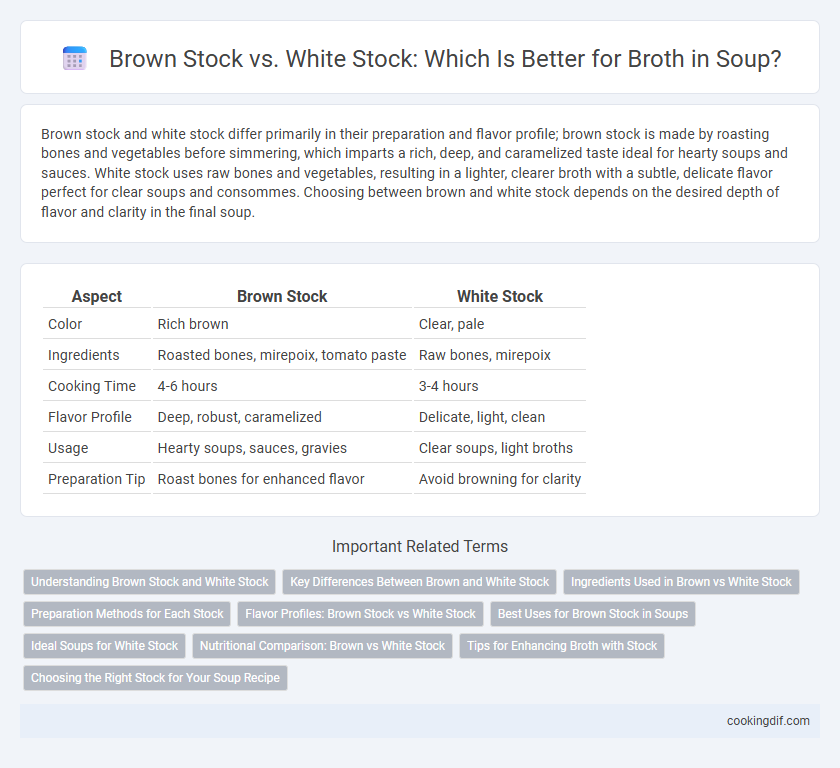Brown stock and white stock differ primarily in their preparation and flavor profile; brown stock is made by roasting bones and vegetables before simmering, which imparts a rich, deep, and caramelized taste ideal for hearty soups and sauces. White stock uses raw bones and vegetables, resulting in a lighter, clearer broth with a subtle, delicate flavor perfect for clear soups and consommes. Choosing between brown and white stock depends on the desired depth of flavor and clarity in the final soup.
Table of Comparison
| Aspect | Brown Stock | White Stock |
|---|---|---|
| Color | Rich brown | Clear, pale |
| Ingredients | Roasted bones, mirepoix, tomato paste | Raw bones, mirepoix |
| Cooking Time | 4-6 hours | 3-4 hours |
| Flavor Profile | Deep, robust, caramelized | Delicate, light, clean |
| Usage | Hearty soups, sauces, gravies | Clear soups, light broths |
| Preparation Tip | Roast bones for enhanced flavor | Avoid browning for clarity |
Understanding Brown Stock and White Stock
Brown stock is made by roasting bones and vegetables before simmering, which imparts a deep, rich flavor and a darker color ideal for hearty soups and sauces. White stock uses raw bones and vegetables, resulting in a lighter, more delicate broth commonly used in clear soups and light sauces. Understanding these fundamental differences helps chefs select the appropriate base to enhance the desired taste and appearance of their dishes.
Key Differences Between Brown and White Stock
Brown stock is made by roasting bones and vegetables before simmering, resulting in a deep, rich flavor and dark color, which enhances soups and sauces with a robust, caramelized taste. White stock uses raw bones and vegetables, producing a lighter, clearer broth with a subtle, delicate flavor ideal for dishes requiring a clean and refined base. The Maillard reaction in brown stock key to its complexity contrasts with the gentle extraction process in white stock, affecting both flavor intensity and appearance.
Ingredients Used in Brown vs White Stock
Brown stock utilizes roasted bones, typically beef or veal, combined with mirepoix caramelized to enhance depth and richness, while white stock employs raw bones from chicken or fish with a fresh mirepoix mixture for a lighter flavor. The roasting process in brown stock adds Maillard reaction compounds, contributing to its darker color and robust taste, contrasting with the clear, subtle profile of white stock. Herbs like thyme, bay leaves, and parsley stems are common to both, but brown stock often includes tomato paste to intensify color and umami.
Preparation Methods for Each Stock
Brown stock is prepared by roasting bones and vegetables such as carrots, onions, and celery until deeply caramelized, intensifying flavor through the Maillard reaction, then simmering them with herbs and water for several hours. White stock uses raw, blanched bones and pale vegetables, which are simmered gently without roasting to produce a clear, delicate broth ideal for light soups and sauces. The key difference lies in the roasting step for brown stock that develops a richer color and deeper umami profile, while white stock prioritizes clarity and subtlety in taste.
Flavor Profiles: Brown Stock vs White Stock
Brown stock offers a rich, deep flavor with caramelized notes from roasted bones and vegetables, enhancing soups with a robust, savory complexity. White stock provides a lighter, more delicate taste, made from simmering raw bones and aromatic vegetables without roasting, resulting in a subtle and clean broth ideal for clear soups. The choice between brown and white stock significantly influences the soup's overall flavor profile, balancing intensity and clarity.
Best Uses for Brown Stock in Soups
Brown stock, made from roasted bones and vegetables, offers a rich, deep flavor ideal for hearty soups like French onion or beef barley. Its robust taste enhances complex broths, adding intensity and color that white stock cannot achieve. Brown stock is preferred for soups requiring a savory foundation with pronounced umami and caramelized notes.
Ideal Soups for White Stock
White stock, made by simmering raw chicken, veal, or fish bones without roasting, yields a clear, delicate broth ideal for light soups such as consommes, consomme-based clear soups, and delicate seafood bisques. The mild flavor profile and pale color preserve the subtle ingredients' taste, making it perfect for spring vegetable soups and refined consommes. White stock's gentle aroma enhances soups that require a clean, unobtrusive backbone without overpowering the main ingredients.
Nutritional Comparison: Brown vs White Stock
Brown stock offers a richer nutritional profile due to prolonged roasting of bones and vegetables, which enhances mineral extraction such as calcium, magnesium, and phosphorus. White stock, prepared with raw bones and minimal caramelization, typically contains fewer minerals but retains more delicate flavors and less fat content. The Maillard reaction in brown stock increases antioxidants and amino acids like glutamine, supporting improved gut health compared to white stock.
Tips for Enhancing Broth with Stock
Brown stock, made from roasted bones and vegetables, adds a rich, deep flavor and darker color to broths, enhancing heartiness and complexity. White stock, prepared from raw bones and aromatic vegetables, yields a lighter, clearer broth ideal for delicate soups and refined flavors. Maximizing broth taste involves simmering slowly, skimming impurities, and adding herbs like thyme or bay leaves during cooking to intensify aroma and depth.
Choosing the Right Stock for Your Soup Recipe
Brown stock, made by roasting bones and vegetables before simmering, imparts a rich, deep flavor and darker color to soups like beef stew or French onion. White stock, prepared by gently simmering raw bones without roasting, results in a lighter, more delicate broth ideal for poultry or seafood soups. Selecting between brown and white stock depends on the desired flavor intensity and clarity for your specific soup recipe.
Brown stock vs White stock for broth Infographic

 cookingdif.com
cookingdif.com